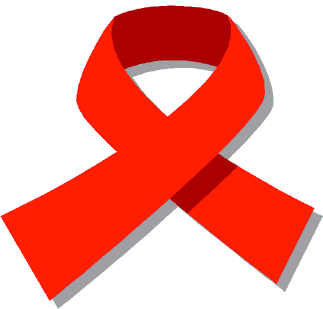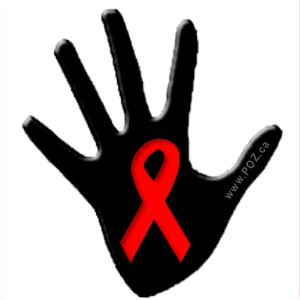This condition progressively reduces the effectiveness of the immune system and leaves individuals susceptible to opportunistic infections and tumors. HIV is transmitted through direct contact of a mucous membrane or the bloodstream with a bodily fluid containing HIV, such as blood, semen, vaginal fluid, preseminal fluid, and breast milk.[4][5]
This transmission can involve anal, vaginal or oral sex, blood transfusion, contaminated hypodermic needles, exchange between mother and baby during pregnancy, childbirth, breastfeeding or other exposure to one of the above bodily fluids.
AIDS is now a pandemic. In 2007, it was estimated that 33.2 million people lived with the disease worldwide, and that AIDS killed an estimated 2.1 million people, including 330,000 children. Over three-quarters of these deaths occurred in sub-Saharan Africa, retarding economic growth and destroying human capital.
Genetic research indicates that HIV originated in west-central Africa during the late nineteenth or early twentieth century. AIDS was first recognized by the U.S. Centers for Disease Control and Prevention in 1981 and its cause, HIV, identified in the early 1980s.
Although treatments for AIDS and HIV can slow the course of the disease, there is currently no vaccine or cure. Antiretroviral treatment reduces both the mortality and the morbidity of HIV infection, but these drugs are expensive and routine access to antiretroviral medication is not available in all countries. Due to the difficulty in treating HIV infection, preventing infection is a key aim in controlling the AIDS pandemic, with health organizations promoting safe sex and needle-exchange programmes in attempts to slow the spread of the virus.
Once HIV has killed so many CD4+ T cells that there are fewer than 200 of these cells per microliter (µL) of blood, cellular immunity is lost. Acute HIV infection progresses over time to clinical latent HIV infection and then to early symptomatic HIV infection and later to AIDS, which is identified either on the basis of the amount of CD4+ T cells remaining in the blood, and/or the presence of certain infections, as noted above.
In the absence of antiretroviral therapy, the median time of progression from HIV infection to AIDS is nine to ten years, and the median survival time after developing AIDS is only 9.2 months. However, the rate of clinical disease progression varies widely between individuals, from two weeks up to 20 years.
Many factors affect the rate of progression. These include factors that influence the body's ability to defend against HIV such as the infected person's general immune function. Older people have weaker immune systems, and therefore have a greater risk of rapid disease progression than younger people.
Poor access to health care and the existence of coexisting infections such as tuberculosis also may predispose people to faster disease progression. The infected person's genetic inheritance plays an important role and some people are resistant to certain strains of HIV. An example of this is people with the homozygous CCR5-Δ32 variation are resistant to infection with certain strains of HIV. HIV is genetically variable and exists as different strains, which cause different rates of clinical disease progression.
Sexual transmission
Sexual transmission occurs with the contact between sexual secretions of one person with the rectal, genital or oral mucous membranes of another. Unprotected receptive sexual acts are riskier than unprotected insertive sexual acts, and the risk for transmitting HIV through unprotected anal intercourse is greater than the risk from vaginal intercourse or oral sex.
However, oral sex is not entirely safe, as HIV can be transmitted through both insertive and receptive oral sex. Sexual assault greatly increases the risk of HIV transmission as condoms are rarely employed and physical trauma to the vagina or rectum occurs frequently, facilitating the transmission of HIV.
Other sexually transmitted infections (STI) increase the risk of HIV transmission and infection, because they cause the disruption of the normal epithelial barrier by genital ulceration and/or microulceration; and by accumulation of pools of HIV-susceptible or HIV-infected cells (lymphocytes and macrophages) in semen and vaginal secretions. Epidemiological studies from sub-Saharan Africa, Europe and North America suggest that genital ulcers, such as those caused by syphilis and/or chancroid, increase the risk of becoming infected with HIV by about fourfold. There is also a significant although lesser increase in risk from STIs such as gonorrhea, chlamydia and trichomoniasis, which all cause local accumulations of lymphocytes and macrophages.
Transmission of HIV depends on the infectiousness of the index case and the susceptibility of the uninfected partner. Infectivity seems to vary during the course of illness and is not constant between individuals. An undetectable plasma viral load does not necessarily indicate a low viral load in the seminal liquid or genital secretions.
However, each 10-fold increase in the level of HIV in the blood is associated with an 81% increased rate of HIV transmission. Women are more susceptible to HIV-1 infection due to hormonal changes, vaginal microbial ecology and physiology, and a higher prevalence of sexually transmitted diseases.
People who have been infected with one strain of HIV can still be infected later on in their lives by other, more virulent strains.
Infection is unlikely in a single encounter. High rates of infection have been linked to a pattern of overlapping long-term sexual relationships. This allows the virus to quickly spread to multiple partners who in turn infect their partners. A pattern of serial monogamy or occasional casual encounters is associated with lower rates of infection.
HIV spreads readily through heterosexual sex in Africa, but less so elsewhere. One possibility being researched is that schistosomiasis, which affects up to 50 per cent of women in parts of Africa, damages the lining of the vagina.
Exposure to blood-borne pathogens
This transmission route is particularly relevant to intravenous drug users, hemophiliacs and recipients of blood transfusions and blood products. Sharing and reusing syringes contaminated with HIV-infected blood represents a major risk for infection with HIV.
Needle sharing is the cause of one third of all new HIV-infections in North America, China, and Eastern Europe. The risk of being infected with HIV from a single prick with a needle that has been used on an HIV-infected person is thought to be about 1 in 150 (see table above). Post-exposure prophylaxis with anti-HIV drugs can further reduce this risk.
This route can also affect people who give and receive tattoos and piercings. Universal precautions are frequently not followed in both sub-Saharan Africa and much of Asia because of both a shortage of supplies and inadequate training.
The WHO estimates that approximately 2.5% of all HIV infections in sub-Saharan Africa are transmitted through unsafe healthcare injections. Because of this, the United Nations General Assembly has urged the nations of the world to implement precautions to prevent HIV transmission by health workers.
The risk of transmitting HIV to blood transfusion recipients is extremely low in developed countries where improved donor selection and HIV screening is performed. However, according to the WHO, the overwhelming majority of the world's population does not have access to safe blood and between 5% and 10% of the world's HIV infections come from transfusion of infected blood and blood products.
Perinatal transmission
The transmission of the virus from the mother to the child can occur in utero during the last weeks of pregnancy and at childbirth. In the absence of treatment, the transmission rate between a mother and her child during pregnancy, labor and delivery is 25%.
However, when the mother takes antiretroviral therapy and gives birth by caesarean section, the rate of transmission is just 1%. The risk of infection is influenced by the viral load of the mother at birth, with the higher the viral load, the higher the risk. Breastfeeding also increases the risk of transmission by about 4 %.
Although the symptoms of immune deficiency characteristic of AIDS do not appear for years after a person is infected, the bulk of CD4+ T cell loss occurs during the first weeks of infection, especially in the intestinal mucosa, which harbors the majority of the lymphocytes found in the body. The reason for the preferential loss of mucosal CD4+ T cells is that a majority of mucosal CD4+ T cells express the CCR5 coreceptor, whereas a small fraction of CD4+ T cells in the bloodstream do so.
HIV seeks out and destroys CCR5 expressing CD4+ cells during acute infection. A vigorous immune response eventually controls the infection and initiates the clinically latent phase. However, CD4+ T cells in mucosal tissues remain depleted throughout the infection, although enough remain to initially ward off life-threatening infections.
Continuous HIV replication results in a state of generalized immune activation persisting throughout the chronic phase. Immune activation, which is reflected by the increased activation state of immune cells and release of proinflammatory cytokines, results from the activity of several HIV gene products and the immune response to ongoing HIV replication. Another cause is the breakdown of the immune surveillance system of the mucosal barrier caused by the depletion of mucosal CD4+ T cells during the acute phase of disease.
This results in the systemic exposure of the immune system to microbial components of the gut’s normal flora, which in a healthy person is kept in check by the mucosal immune system. The activation and proliferation of T cells that results from immune activation provides fresh targets for HIV infection. However, direct killing by HIV alone cannot account for the observed depletion of CD4+ T cells since only 0.01–0.10% of CD4+ T cells in the blood are infected.
A major cause of CD4+ T cell loss appears to result from their heightened susceptibility to apoptosis when the immune system remains activated. Although new T cells are continuously produced by the thymus to replace the ones lost, the regenerative capacity of the thymus is slowly destroyed by direct infection of its thymocytes by HIV. Eventually, the minimal number of CD4+ T cells necessary to maintain a sufficient immune response is lost, leading to AIDS
Cells affected
The virus, entering through which ever route, acts primarily on the following cells:
• Lymphoreticular system:
o CD4+ T-Helper cells
o Macrophages
o Monocytes
o B-lymphocytes
• Certain endothelial cells
• Central nervous system:
o Microglia of the nervous system
o Astrocytes
o Oligodendrocytes
o Neurones – indirectly by the action of cytokines and the gp-120
The effect
The virus has cytopathic effects but how it does it is still not quite clear. It can remain inactive in these cells for long periods, though. This effect is hypothesized to be due to the CD4-gp120 interaction.
• The most prominent effect of HIV is its T-helper cell suppression and lysis. The cell is simply killed off or deranged to the point of being function-less (they do not respond to foreign antigens). The infected B-cells can not produce enough antibodies either. Thus the immune system collapses leading to the familiar AIDS complications, like infections and neoplasms (vide supra).
• Infection of the cells of the CNS cause acute aseptic meningitis, subacute encephalitis, vacuolar myelopathy and peripheral neuropathy. Later it leads to even AIDS dementia complex.
• The CD4-gp120 interaction (see above) is also permissive to other viruses like Cytomegalovirus, Hepatitis virus, Herpes simplex virus, etc. These viruses lead to further cell damage i.e. cytopathy.
Molecular basis
For details, see:
• Structure and genome of HIV
• HIV replication cycle
• HIV tropism























No comments:
Post a Comment